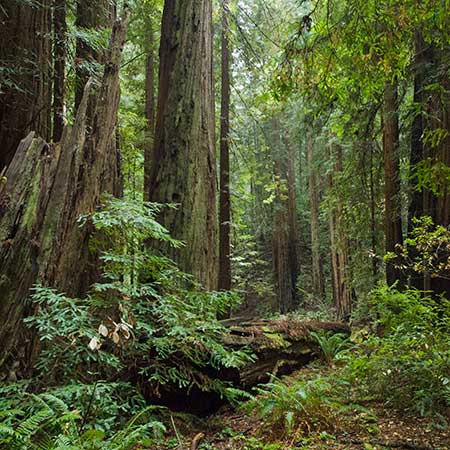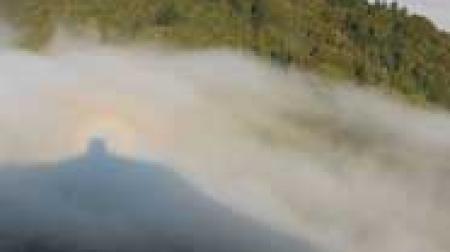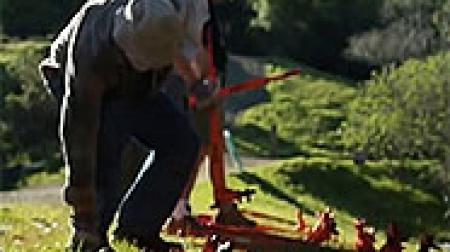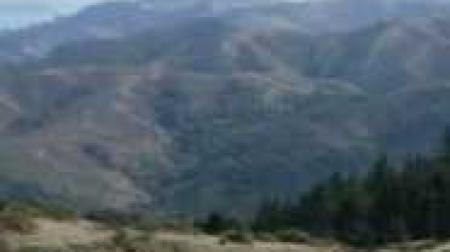Why Was This Indicator Chosen?
Coast redwoods are the definition of resiliency. Among the tallest trees in the world, individual redwoods may live as long as 2,000 years. Thick bark and an ability to resprout enables established adult trees to survive most wildfires, high levels of tannins make them resistant to insect and fungal infestations, and acidic soil conditions, thick duff layers, and dense shade also make coast redwood forests relatively resistant to non-native plant invasions.
Mt. Tam’s coast redwood forests provide important habitat for a number of mammals and birds, including the state and federally threatened Northern Spotted Owl (Strix occidentalis caurina). Endangered coho salmon (Oncorhynchus kisutch) and threatened steelhead trout (O. mykiss) also live in the Redwood Creek Watershed on Mt. Tam.
Redwood forest communities are also good indicators of forest management practices, wildfire regimes, disease processes, and climate change. Coast redwood trees sprout prolifically from stumps, and many of Mt. Tam’s second-growth stands have higher redwood tree densities than old-growth areas as a result of turn of the century logging (Noss, 2000). High densities of tanoak (Notholithocarpus densiflorus) and Douglas-fir (Pseudotsuga menziesii) in second-growth redwood stands in some areas reflects a history of logging, followed by fire suppression and a lack of management actions designed to favor redwood recruitment.
Wide-spread tanoak die-back and resprouting as a result of Sudden Oak Death (SOD) has led to a persistent thicket of tanoak shoots in the redwood understory. The continual re-infection of these tanoaks prevents the shoots from developing into midstory level trees, and has reduced the habitat complexity of the mountain's redwood forests.
Finally, redwoods may serve as an indicator of climate change, particularly changes in precipitation patterns and summer fog (Micheli et al., 2016). A sudden decline in such a long-lived and resilient species would signify changes on a scale likely to be detrimental to other vegetation communities on Mt. Tam.
What is Healthy?
The desired condition for old-growth redwood forests is to sustain complex species composition and stand structure including multi-aged, multi-storied stand structure, coarse woody debris, tree cavities, and nesting structures.
In second-growth forests, the desired condition is evidence that a stand is on a trajectory towards development of old-growth characteristics. This includes a reduction in the total stem density over time as well as the development of large diameter trees and a multi-storied stand structure (Lorimer, 2009).
What Are the Biggest Threats?
- The death of tanoaks, an important part of the coast redwood forest structure, from Sudden Oak Death
- Warming temperatures, and changes to fog and precipitation patters as a result of climate change
- Invasive, non-native species such as panic veldtgrass (Ehrharta erecta), which are able to persist in the shady redwood understory
- Soil compaction from recreational use of redwood forests both on and off trails
What is The Current Condition?
Old-growth redwood forests are in Good condition while second-growth areas are in Fair condition. Because the vast majority of the redwood forests on Mt. Tam are second-growth, the overall trend is Fair. The mountain's second-growth stands lack the complex structure of old-growth areas, primarily as a result of the effects of SOD.
What is the Current Trend?
The trend for old-growth redwood forests is Improving, but second-growth redwood stands are Declining, again, primarily as a result of SOD.
How Sure Are We?
We have High confidence in our assessment for old-growth stands but somewhat less data on second-growth stands, yielding a Moderate confidence level for these areas.
What is This Assessment Based On?
- NPS 1994 vegetation map (Schirokauer, 2013)
- MMWD vegetation maps from 2004, 2009, 2014 (AIS, 2015)
- MMWD broom mapping from 2003 drive-by survey
- MMWD 2014 photo interpretation of SOD affected forest stands (AIS, 2015)
- MCP 2008 vegetation map (AIS, 2008)
- One Tam 2016 early detection and invasive plant mapping (The Calflora Database, 2016)
- Larry Fox and Joe Saltenberger old-growth redwood data (Save the Redwoods League, 2011)
What Don’t We Know?
Key information gaps include:
- Quantification of complex/Old-growth habitat structure including measuring and mapping coarse woody debris, tree cavities, and nesting platforms
resources
Aerial Information Systems, Inc. (2008). Marin County Open Space District Vegetation Photo Interpretation and Mapping Classification Report, prepared by Aerial Information Systems, Inc. for Marin County Parks.
Aerial Information Systems, Inc. (2015). Summary Report for the 2014 Photo Interpretation and Floristic Reclassification of Mt. Tamalpais Watershed Forest and Woodlands Project, prepared by Aerial Information Systems, Inc. for the Marin Municipal Water District.
Lorimer, C. G., Porter, D. J., Madej, M. A., Stuart, J. D., Veirs, S D., Norman, S. P., O’Hara, K. L., Libby, W. J. (2009). Presettlement and modern disturbance regimes in coast redwood forests: Implications for the conservation of old-growth stands. Forest Ecology & Management, 258, 1038–1054. Available from: http://www.srs.fs.usda.gov/pubs/ja/ja_lorimer001.pdf?.
Micheli, E., Flint, L., Veloz, S., Johnson (Higgason), K., & Heller, N. (2016). Climate Ready North Bay Vulnerability Assessment Data Products: 1. North Bay Region Summary. A technical memorandum prepared by the Dwight Center for Conservation Science at Pepperwood, Santa Rosa, CA, for the California Coastal Conservancy and Regional Climate Protection Authority. Available from: http://climate.calcommons.org/sites/default/files/basic/CRNB%20North%20Bay%20Region%20technical%20memo.pdf.
Noss, R.F. (Editor). (2000). The Redwood Forest: History, Ecology and Conservation of the Coast Redwood. Washington, DC: Island Press.
Schirokauer, D., Keeler-Wolf, T., Meinke, J., & van der Leeden, P. (2003). Plant Community Classification and Mapping Project Final Report - December 2003 Point Reyes National Seashore, Golden Gate National Recreation Area, San Francisco Water Department Watershed Lands, Mount Tamalpais, Tomales Bay, and Samuel P. Taylor State Parks. Available from: http://www1.usgs.gov/vip/pore_goga/pore_gogarpt.pdf.




